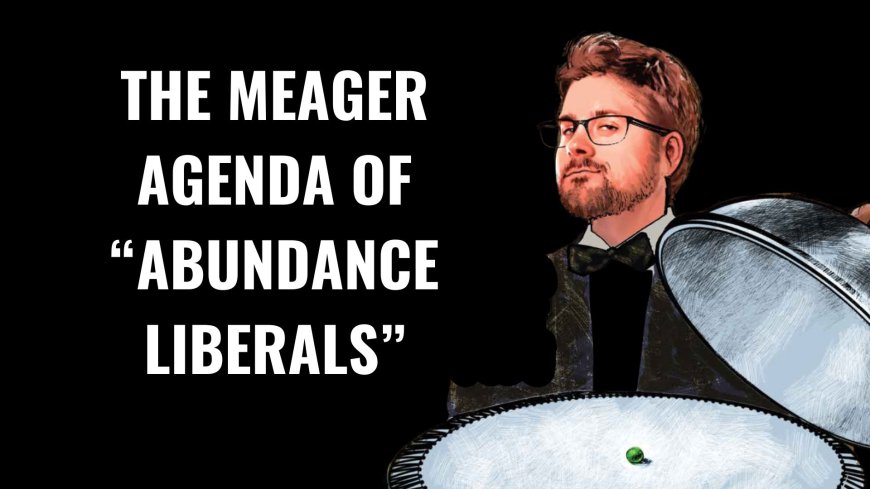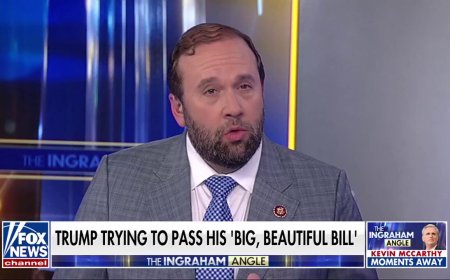Ep. 13: The Hot (or Not) New Theory of “Abundance Liberalism” | w/ Paul Glastris and Nate Weisberg

Anne Kim: You two have written quite a barn burner for the latest issue of the Washington Monthly. Your target is so-called “abundance liberalism” — a white-hot theory in Democratic circles championed by folks like The New York Times’ Ezra Klein and The Atlantic’s Derek Thompson, who recently published a book called Abundance. For listeners who might not be following the latest intellectual trends on the progressive left, can you explain what abundance liberalism is?
Nate Weisberg: Sure. Klein and Thompson’s Abundance is just one of many recent works trying to diagnose why government struggles to deliver on big goals — in areas like housing, energy, and transportation. The core argument is that well-meaning regulations, whether federal or local, have unintentionally gotten in the way of building more housing, healthcare, clean energy, and so on. The problems vary by sector, but the through line is a critique of bureaucratic bottlenecks.
Anne Kim: Why has this critique gained traction now? Regulatory reform has been a focus of New Democrats for decades — think Clinton’s “reinventing government” push, or Obama’s OIRA under Cass Sunstein. What’s different now? Is it the packaging, the messengers, or something else?
Paul Glastris: Well, I’m not sure the broader left is actually that into it. This is more of an elite conversation—think tankers, donors, a few Democratic politicians looking for something fresh. There’s a sense that the party has a brand problem, and abundance liberalism seems to offer a policy-forward way to rebrand. But most voters have never heard of it. If you’re a loyal New York Times reader or follow Matt Yglesias on Substack, maybe you’re familiar. But it’s still pretty niche.
That said, the core idea is straightforward: government red tape is blocking progress on big goals—housing affordability, climate action, infrastructure. And they’re not wrong that bureaucracy and outdated rules can be a problem. But our argument is: even if you implemented every reform they propose, it wouldn’t come close to solving the problems they want to fix. There’s a lot more standing in the way—especially in the private sector—that they mostly ignore.
Anne Kim: You do credit them in your piece for being pragmatic and willing to challenge their own side. You write that they’re “centrist thinkers plotting a revival of liberalism through pragmatism and policy innovation,” which sounds pretty appealing. But you also argue that their theory of change is incomplete. What are they leaving out?
Nate Weisberg: One big omission is their framing of progressives as the main obstacle to clean energy. Yes, there are environmental laws that have slowed down projects, and some groups on the left oppose permitting reform if it means compromising on natural gas drilling. But the bigger idea that progressives are primarily to blame for blocking our green energy transition is ridiculous when you step back and think about it. Who’s really blocking our green energy transition? It’s the entire Republican Party, which is fundamentally opposed to a green economy. Trump is already punishing clean energy permits—and his party backs him all the way.
Paul Glastris: Exactly. Sure, some environmental rules need reform. And to their credit, most Democrats supported a permitting reform bill a few years ago. Republicans, by and large, didn’t. But more importantly, the biggest barriers to building, say, transmission lines aren’t activists or environmental reviews—they’re monopoly utilities and regional grid operators who don’t want competition from renewables. Their business model depends on burning fossil fuels and charging for it. That’s a huge structural problem—and you hear nothing about it from the abundance crowd.
Anne Kim: But you do share some goals with them, right? Both of you want the private sector to thrive. That pro-growth mindset isn’t something we always associate with the progressive left.
Paul Glastris: Definitely. We give them credit for rejecting the scarcity mindset that can dominate left-wing thinking. They’re optimistic about technology—desalination, lab-grown meat, renewable energy—and they’re right that abundance is possible. But our argument is: you don’t get there just by tweaking a few permitting rules. If we don’t address monopoly power and the ways private actors block progress, we’re not going to see the transformation they envision.
Anne Kim: I want to bring up Elon Musk and DOGE. Musk is the ultimate techno-libertarian—his project seems aimed at bulldozing government entirely. Do you think what he’s doing undermines the abundance liberal project? Is this what deregulation run amok looks like?
Nate Weisberg: It’s a good comparison point, but Klein and Thompson aren’t Musk-style libertarians at all. They actually believe in a strong, competent government. They want more capacity, not less—better state transportation departments, faster permitting turnarounds. But you’re right: their arguments about deregulation don’t really offer us much for responding to someone like Musk, who’s actively working to dismantle government capacity.
Paul Glastris: Yeah, a fair reading of the abundance literature shows they’re not anti-government. In fact, some of their best work is about improving public institutions. And they’d probably argue that government dysfunction helped create a vacuum that Musk is now exploiting. They’re not wrong. But here’s the issue: Musk isn’t just any private actor. He’s an oligarch. And when you have billionaires owning the platforms, shaping the media, and cozying up to authoritarian figures, it’s dangerous. If your policy agenda ignores this consolidation of power, you’re not engaging with the real stakes.
Nate Weisberg: And they really do ignore it. Whether it’s energy, housing, or transit, they just sort of skip over the role of monopoly actors. We’ve read all their stuff—and the silence on corporate concentration is striking. I think part of the reason is that they’re trying to build a big-tent coalition in the think tank world. There’s something in abundance liberalism for everyone: libertarians who like deregulation, centrists who want housing reform, even climate activists. But that means leaving out the neo-Brandeisians—folks like us at the Washington Monthly—who focus on market power and economic concentration.
Anne Kim: Let’s talk about housing. One of abundance liberalism’s big ideas is that local zoning laws—especially in blue cities like San Francisco and New York—are making housing unaffordable for the middle and working class. What’s your take on that?
Paul Glastris: It’s true that exclusionary zoning has made it hard to build. And the YIMBY movement—Yes In My Backyard—has been pushing to allow things like duplexes, fourplexes, accessory dwelling units. In some places, like Minneapolis and parts of California and Oregon, reforms have passed. But the data so far shows that these changes haven’t produced much housing. Why? Because there’s not a lot of demand for dense apartments in car-centric suburban neighborhoods.
What these reforms have created is backlash—people worried about property values. If the Democratic Party centers its economic message around abolishing single-family zoning, we’re going to be in the wilderness for decades.
Nate Weisberg: And the frustrating part is there are zoning reforms that work. Targeted upzoning around transit corridors—places with bus lines or metro stops—has led to real results: lower rents, less homelessness, more walkable urban communities.
Paul Glastris: And we’ve been calling for that kind of reform at the Washington Monthly for 15 years. So the abundance liberals are right to push for change—but their specific solutions range from vague to politically toxic.
Anne Kim: Paul, you worked as a speechwriter in the Clinton White House. Clinton was a master of political messaging. Do you think “abundance” is the right word for what Democrats should be trying to sell?
Paul Glastris: I’m not a messaging guru, but I do think the instinct is right. We need a story about growth and progress—something that offers hope without being naïve. But permitting reform and zoning tweaks? That’s not a compelling agenda. What we really need is a story about how monopolies are crushing competition and holding back entrepreneurs. We need policies that create more millionaires and fewer billionaires. That’s classic American stuff—spreading opportunity, promoting competition—and we’ve moved away from it.
Anne Kim: Paul, you and your colleagues wrote a series of essays at the start of the year outlining ideas that could form the backbone of a new progressive agenda. Could you walk us through a few of those—just to give listeners a sense of the kind of vision you’d like to see emerge over the next few years?
Paul Glastris: Sure. One straightforward idea is what we call “Medicare prices for all.” The basic premise is: require hospitals, doctors, and insurers to charge roughly what Medicare pays for any given procedure, office visit, or prescription. Right now, there’s no competitive market in healthcare. You’ve got these massive hospital systems that own the insurance companies, the labs, the doctor’s offices—they can charge whatever they want.
That system is broken. By bringing prices in line with Medicare, we could put thousands of dollars back into the pockets of average Americans. The savings would trickle down to workers, since employers could lower their healthcare contributions and redirect that money toward wages. It’s a win-win.
Another big idea: focus on the self-employed. Gig workers, contractors, Uber drivers—tens of millions of people. Somewhere between 10 and 30 percent of the workforce. It’s the fastest-growing segment, and it’s incredibly diverse—heavily women, heavily people of color. Yet neither party is speaking directly to them. They don’t get benefits, they’re taxed unfairly, and they’re often exploited by tech platforms. There’s a wide-open policy lane here, and whoever gets there first—Democrats or anti-Trump Republicans—has a huge opportunity.
Permitting reform? Sure, add it to the list. But it’s just one piece of a much larger puzzle.
Anne Kim: Yeah, that’s such an important point—especially about the shift away from the old employer-based benefits model, which really grew out of World War II. The tax system sort of locked it in with employer deductions, but the economy has changed. Work has changed. People don’t stay at one company for life anymore. But our regulatory structure hasn’t caught up at all.
Paul Glastris: Exactly. And to be honest, labor unions—which are an essential part of the Democratic coalition—haven’t quite adapted either. They’d often prefer that gig workers become traditional employees so they can be unionized. But many of these workers like their independence. They want flexibility, but they still need support—portable benefits, protections against exploitation, and a fair tax structure. There’s an entire agenda here, just waiting for someone to own it.
Nate Weisberg: And to make it worse, these workers pay more in taxes. Gig workers are hit with both the employer and employee sides of FICA payroll taxes—for Social Security, Medicare, health insurance, everything. That’s a huge burden. It’s a structural unfairness that hits precisely the group most in need of help. Fixing that would make a real difference and there’s a real opportunity there.
Paul Glastris: Democrats do have some wins to point to here, as well. Obamacare gave a lot of people in the gig economy access to health insurance they wouldn’t have had otherwise. But they need to build on that. There’s a story to tell—but also a lot of work to do.
Nate Weisberg: And again, abundance can be a useful frame. We agree with the aspiration: let’s have plenty of housing, energy, opportunity. But the question isn’t whether we want abundance. Of course we do. The question is: how do we get there?
Anne Kim: Right—nobody’s campaigning on scarcity. So what else would you like to see coming out of the center-left or the Democratic Party in the next few years? What’s the opportunity?
Paul Glastris: That’s a big question. We touch on it in the piece, but here’s how I see it: right now, we have a federal government that’s essentially attacking itself. It’s like an autoimmune disease. The capacity of agencies to do their jobs is being hollowed out—and a member of the tech oligarchy has been given free rein to slash and burn however he wants.
That’s not going to end well. One path is a slide toward illiberal democracy or soft authoritarianism. But the more immediate risk is catastrophic failure—millions of people not getting Social Security checks, a bird flu outbreak overwhelming a gutted CDC. We’ve got a piece in the next issue arguing that Guam could be the next Pearl Harbor if China decides to make a move on Taiwan.
Nate Weisberg: If Xi is listening to our President it wouldn’t be unreasonable for him to conclude that now is a perfect time to invade.
Paul Glastris: Exactly. We could see things happen in the next few years that really shatter the widespread assumption that we can just ignore government and trust the private sector. That crisis—if it comes—will be a chance for Democrats to step in and say, “Here’s the plan to rebuild.” And we’ve written that plan: invest in government capacity, hire competent public servants, and stop outsourcing everything to massive, unaccountable consulting firms.
Right now, a huge share of federal work is done by contractors—Musk is just the most visible example. But there are thousands more: big consulting firms billing billions, often with very little oversight. The civil service has been hollowed out. We no longer have the people, the skills, or the authority to manage these contractors effectively. That’s the root of a lot of what the abundance liberals blame on “process.” But it’s not process. It’s personnel.
We need to bring skilled people into government, give them real authority, and reduce our dependency on outside firms. And honestly, that’s a message that might start to resonate with voters—especially as things continue to break.










































